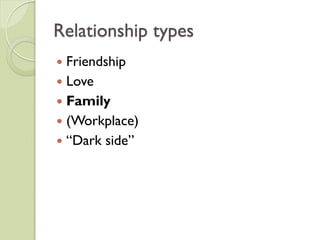Signaler
Partager
Télécharger pour lire hors ligne

Contenu connexe
Similaire à Com120 10 part 3
Similaire à Com120 10 part 3 (6)
Vision for a Strong Marriage: Secrets of Strong, Loving Couples

Vision for a Strong Marriage: Secrets of Strong, Loving Couples
High and low context cultures relationships in each

High and low context cultures relationships in each
Realizations at Alberta Association for Community Living Apr 2012

Realizations at Alberta Association for Community Living Apr 2012
Plus de turnercom
Plus de turnercom (20)
Com120 10 part 3
- 1. Relationship types Friendship Love Family (Workplace) “Dark side”
- 2. Family Characteristics ◦ Defined Roles ◦ Recognition of Responsibilities ◦ Shared History and Future ◦ Shared Living Space
- 3. Family Couples: ◦ Traditional ◦ Independent ◦ Separate
- 4. Family Types: ◦ Conformity vs. Conversation
- 5. Family Types: Protective: Consensual: • High • High Conformity Conformity • Low • High Conversation Conversation Laissez-Faire: Pluralistic: • Low • Low Conformity Conformity • Low • High Conversation Conversation
- 6. Family Communication Patterns ◦ Equality ◦ Balanced Split ◦ Unbalanced Split ◦ Monopoly